

Book lovers from sea to shining sea tuned in to PBS last night for “Who Am I?”, the first themed episode in The Great American Read—a new eight-part series that explores and celebrates the power of reading, told through the prism of America’s 100 favorite novels.
“Who Am I?” focused on some of the the country’s most beloved coming-of-age stories—books like To Kill a Mockingbird, A Tree Grows in Brooklyn, and The Catcher in the Rye, which have helped countless readers to understand their own identities and find their place in the world—and featured a host of fascinating interviews with Lauren Graham, John Green, S.E. Hinton, John Irving, Yahdon Israel, Devon Kennard, Diane Lane, George Lopez, Lisa Lucas, Armistead Maupin, Jason Reynolds, Joshua Rothman, Parul Seghal, Kevin Young, and others.
As we’ll be doing the day after each week’s themed episode from now until the grand finale on October 23, we looked back through our Classic Reviews Archive to bring you what the critics said about some of these now-iconic books.
*

A Tree Grows in Brooklyn, Betty Smith
The world was hers for the reading.
“A first novel of unusual quality and understanding, written with strong realism and compassion, sometimes bald, always human, this rightfully ranks with the Farrell genre, though, to my thinking, there is better balance and more sympathy. The slums of Brooklyn, and the Irish Catholics, form the setting for the story of Francie Nolan and her family: Johnny, her father, handsome and shiftless; Katie, her mother, hardening under years of poverty and improvidence; Neeley, Katie’s favorite child; Aunt Sissy, a good ‘bad woman,’ and chiefly Francie herself, gentle, shy, imaginative. The reader shares her humiliations at school, loss of face and pride her real sorrow when her father drinks himself to death; her ambition for a college education, thwarted when she must go to work at 14; her first love affair and disillusionment. Lusty—sometimes funny—consistently moving, this is a book for a discriminating public, not too tender skinned. But not for some Public Library open shelves.”
*
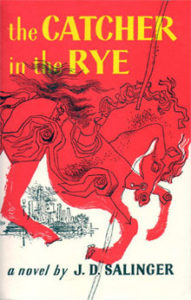
The Catcher in the Rye, J. D. Salinger
What really knocks me out is a book that, when you’re all done reading it, you wish the author that wrote it was a terrific friend of yours and you could call him up on the phone whenever you felt like it. That doesn’t happen much, though.
“Mr. Salinger’s brilliant, funny, meaningful novel is written in the first person. Holden Caulfield is made to tell his own story, in his own strange idiom. Holden is not a normal boy. He is hypersensitive and hyper-imaginative (perhaps these are synonymous). He is double-minded. He is inexorably self-critical; at various times, he refers to himself as yellow, as a terrible liar, a madman, a moron.
…
“The literalness and innocence of Holden’s point of view in the face of the tremendously complicated and often depraved facts of life make for the humor of this novel: serious haggles with belligerent taxi-drivers; abortive conversational attempts with a laconic prostitute in a hurry; an ‘intellectual’ discussion with a pompous and phony intellectual only a few years older than himself; an expedition with Sally Hayes, which is one of the funniest expeditions, surely, in the history of juvenilia. Holden’s contacts with the outside world are generally extremely funny. It is his self-communings that are tragic and touching—a dark whirlpool churning fiercely below the unflagging hilarity of his surface activities.”
–S. N. Behrman, The New Yorker, August 11, 1951
*

A Separate Peace, John Knowles
I felt that I was not, never had been and never would be a living part of this
overpoweringly solid and deeply meaningful world around me.
“A coming-of-age tale set in a New England boarding school, it bears immediate comparison to its better known contemporary The Catcher in the Rye, but is an altogether gentler, more quietly brilliant book.
The school, Devon, acquires the status of a kind of American Eden in Knowles’ story. Set shortly after America’s entry to the Second World War, the boys of the Upper Middle class are still ‘calmly, numbly reading Virgil,’ while men little older than them are already in khaki.
The war rages off-stage, dimly viewed through newspaper stories, but Devon maintains a luminous innocence – embodied in the novel’s most vivid character, Phineas, or Finny, an open-hearted, unaffected, athletic 16-year-old, who is the object of the admiration and buried envy of our narrator, Gene.
The plot turns on one random act of violence, as Gene knocks Finny out of a tree, crippling him. Neither of the boys ever admits to themselves that the blow was deliberate and it is, as Gene himself notes, a small crime in a world at war, in which ‘ships were being torpedoed dropping thousands of men in the icy ocean, whole city blocks were exploding into flame in an instant.’
But the act disturbs the peace of Devon, and the seemingly timeless rhythms of the school year. The world beyond the stately buildings and the playing fields begins to encroach, and the war in far-off Europe and Asia beckons America’s innocents…For Knowles, the school is America itself in miniature—moving from the innocence of isolation to the cruel experience of a global war.
…
“For Knowles, growing up, and experience, means facing up to the idea of threat in the world, and he skilfully depicts the different boys’ reactions to it. Finny alone remains wholly true to himself and refuses to recognise that he has an enemy—a kind of innocence, which, in the cruelty of the world beyond a sheltered adolescence in a time of peace, is doomed.”
–Charlie Cooper, The Independent, August 14, 2014
*
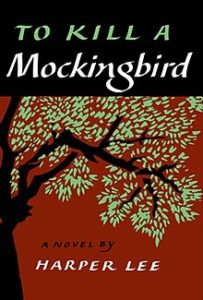
To Kill A Mockingbird, Harper Lee
You never really understand a person until you consider things from his point of view …
Until you climb inside of his skin and walk around in it.
“The rape trial, Jem’s helling, and even Boo Radley are deeply involved in the irregular and very effective education of Scout Finch. By the time she ends her first-person account at the age of nine, she has learned that people must be judged, but only slowly and thoughtfully.
Author Lee, 34, an Alabaman, has written her first novel with all of the tactile brilliance and none of the preciosity generally supposed to be standard swamp-warfare issue for Southern writers. The novel is an account of an awakening to good and evil, and a faint catechistic flavor may have been inevitable. But it is faint indeed; Novelist Lee‘s prose has an edge that cuts through cant, and she teaches the reader an astonishing number of useful truths about little girls and about Southern life.”
*
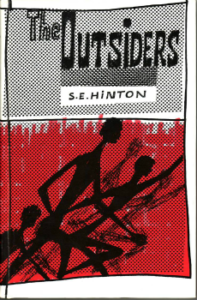
The Outsiders, S. E. Hinton
They grew up on the outside of society. They weren’t looking for a fight. They were looking to belong.
“At a time when the average young-adult novel was, in Hinton’s characterization, ‘Mary Jane went to the prom,’ The Outsiders shocked readers with its frank depictions of adolescents smoking, drinking and ‘rumbling.’ Although other pop culture offerings had dealt with these themes — most notably Rebel Without a Cause and West Side Story—their intended audience was adult. By contrast, The Outsiders was a story ‘for teenagers, about teenagers, written by a teenager.’ Hinton’s candid, canny appraisal of the conflict between Socs, or Socials, and Greasers (for which one might substitute Jets and Sharks), published when she was 17, was an immediate hit and remains the best-selling young-adult novel of all time.
Long credited with changing the way Y.A. fiction is written, Hinton’s novel changed the way teenagers read as well, empowering a generation to demand stories that reflected their realities.”
–Dale Peck, The New York Times Book Review, September 23, 2007
*

A Prayer for Owen Meany, John Irving
If you care about something you have to protect it—If you’re lucky enough to find a way of life you love,
you have to find the courage to live it.
“Accidents usually accelerate John Irving’s antic plots and keep his readers tuned for what happens next. A Prayer for Owen Meany takes a somewhat different approach. Framed by the myth of victim as redeemer, the book removes guesswork without reducing expectations. One knows going in that the mischievous author is staging a kind of Gospel According to Charlie Brown. But anyone familiar with Irving’s mastery of narrative technique, his dark humor and moral resolve also knows his fiction is cute like a fox.
…
“Despite its theological proppings, A Prayer for Owen Meany is a fable of political predestination. As usual, Irving delivers a boisterous cast, a spirited story line and a quality of prose that is frequently underestimated, even by his admirers. On the other hand, the novel invites trespass by symbol hunters. One can easily imagine college sophomores arguing over the meaning of a stuffed armadillo that has had its claws removed, or the significance of Wheelwright’s carrying his small friend on his shoulders to slam-dunk a basketball. For graduate students there is the fact that Meany shares more than initials with Oskar Matzerath, the runt hero of Gunter Grass’s masterpiece, The Tin Drum.
To get lost in critical rummage would be to miss the point. Irving’s litany of error and folly may strike some as too righteous; but it is effective. His glaring capital letters aside, Meany reminds us that, after the nostrums of the Great Communicator, news should be more than what we did not know yesterday and are likely to forget tomorrow.”
–R.Z. Sheppard, TIME, June 24, 2001
*

The Book Thief, Markus Zusak
I have hated words and I have loved them, and I hope I have made them right.
“The Australian writer Markus Zusak’s brilliant and hugely ambitious new young-adult novel is startling in many ways, but the first thing many teenagers will notice is its length: 552 pages! It’s one thing to write a long book about, say, a boy who happens across a dragon’s egg; it’s quite another to write a long, achingly sad, intricately structured book about Nazi Germany narrated by Death itself.
…
“All of Zusak’s protagonists have been fighters, whether born or made. But while his writing has always been ambitious and his characterizations precise, his early books merely celebrated fighting. In The Book Thief, where battling to survive is sometimes an act of weakness, we see fighting in all its complexity
…
“Some will argue that a book so difficult and sad may not be appropriate for teenage readers. “The Book Thief” was published for adults in Zusak’s native Australia, and I strongly suspect it was written for adults. Adults will probably like it (this one did), but it’s a great young-adult novel. Many teenagers will find the story too slow to get going, which is a fair criticism. But it’s the kind of book that can be life-changing, because without ever denying the essential amorality and randomness of the natural order, “The Book Thief” offers us a believable, hard-won hope. That hope is embodied in Liesel, who grows into a good and generous person despite the suffering all around her, and finally becomes a human even Death can love. The hope we see in Liesel is unassailable, the kind you can hang on to in the midst of poverty and war and violence. Young readers need such alternatives to ideological rigidity, and such explorations of how stories matter. And so, come to think of it, do adults.”
–John Green, The New York Times Book Review, May 14, 2006
*
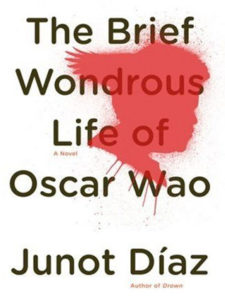
The Brief Wondrous Life of Oscar Wao, Junot Díaz
But if the years have taught me anything it is this: You can never run away. Not ever. The only way out is in.
“In The Brief Wondrous Life of Oscar Wao, Díaz shows impressive high-low dexterity, flashing his geek credentials, his street wisdom and his literary learning with equal panache.
…
“Díaz’s novel also has a wild, capacious spirit, making it feel much larger than it is. Within its relatively compact span, The Brief Wondrous Life of Oscar Wao contains an unruly multitude of styles and genres. The tale of Oscar’s coming-of-age is in some ways the book’s thinnest layer, a young-adult melodrama draped over a multigenerational immigrant family chronicle that dabbles in tropical magic realism, punk-rock feminism, hip-hop machismo, post-postmodern pyrotechnics and enough polymorphous multiculturalism to fill up an Introduction to Cultural Studies syllabus. Holding all this together—just barely, but in the end effectively—is a voice that is profane, lyrical, learned and tireless, a riot of accents and idioms coexisting within a single personality.
…
“Trujillo proves to be a great boon for Díaz, who washes the cities and villages of his country in the 1940s and ’50s in a period ambience that’s violent as well as sensual and exotic. The island may be cursed and haunted, but it’s also enchanted; even the bitterest memories seem softened by nostalgia. The evil spirits that are periodically invoked to explain Oscar’s family’s bad luck are also, for the novelist if not for his characters, lucky charms.
“Without the horrors and superstitions of the old country, without the tropical sweetness that inflects Díaz’s prose even at moments of great cruelty, Oscar Wao would be just another geek with an Akira poster on his dorm-room wall and a long string of desperate, unconsummated sexual obsessions. The incongruity between Oscar’s circumstances and his background—a disjunction Díaz solves violently and unconvincingly in the book’s final section—is the real subject of The Brief Wondrous Life of Oscar Wao. This is, almost in spite of itself, a novel of assimilation, a fractured chronicle of the ambivalent, inexorable movement of the children of immigrants toward the American middle class, where the terrible, incredible stories of what parents and grandparents endured in the old country have become a genre in their own right.”
–A. O. Scott, The New York Times Book Review, September 30, 2007
*
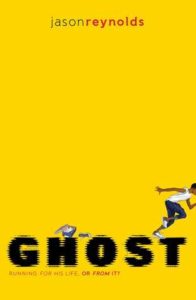
Ghost, Jason Reynolds
You can’t run away from who you are, but what you can do is run toward who you want to be.
“Ghost’s transformation is slow and believable. At first, he lacks the gear and the tenacity to perform well. At night, Ghost sleeps near the door, in case he and his mom have to run again. At school, he gets in trouble and struggles to contain his fear and anger. As Ghost puts it, ‘I got a lot of scream inside.’
Over time, training produces results. Anyone who’s felt gravel crunch under their spikes will recognize Coach’s workouts — the exhausting fartleks and distance runs, the competitive banter. Athletes understand that one step forward is often followed by two steps back, and Ghost’s emotional strength comes around more slowly than his speed.
…
“Though this novel belongs to Ghost, his teammates are fully realized characters with dreams, histories, gifts and imperfections of their own. The girls are never pushed to the side. Patina, especially, not only shines on the track but asserts herself in Coach’s car one day, refusing to give up her shotgun seat so the boys won’t be crowded in back. Readers who connect with these other runners will be thrilled to know that Ghost is the first in a promised series from Reynolds, each featuring a different narrator from the Defenders.
As for Ghost, it’s easy to praise Reynolds’s vivid depiction of life in Ghost’s urban neighborhood as one that’s challenging and full of warmth, relationships and hope. But this book’s biggest strength is Ghost himself. Reynolds has created a character whose journey is so genuine that he’s worthy of a place alongside Ramona and Joey Pigza on the bookshelves where our most beloved, imperfect characters live.”
–Kate Messner, The New York Times Book Review, August 26, 2016
***
The Great America Read TV Schedule
“Who Am I?”
Tuesday, September 18, 8:00-9:00 p.m. ET
Explore the ways that America’s best-loved novels answer the age-old question, “Who Am I?” From life lessons to spiritual journeys, these books help us understand our own identities and find our place in the world.
“Heroes”
Tuesday, September 25, 8:00-9:00 p.m. ET
Follow the trials and tribulations of some of literature’s favorite heroes. From Katniss Everdeen to Don Quixote, examine how the everyday hero and the anti-hero find their inner strength, overcome challenges and rise to the occasion.
“Villains and Monsters”
Tuesday, October 2, 8:00-9:00 p.m. ET
Learn why literature’s most notorious villains began behaving badly. Many weren’t born evil, but became that way when faced with some of the same choices we make every day. See what these villains can teach us about our own dark impulses.
“What We Do For Love”
Tuesday, October 9, 8:00-9:00 p.m. ET
Fall in love with some of literature’s most beautiful romances and explore the many forms of love, from family to passion to the unrequited type. Learn how America’s best-loved novels reflect the things we do for love.
“Other Worlds”
Tuesday, October 16, 8:00-9:00 p.m. ET
Take a magical journey to another world through some of America’s best-loved novels. From Middle Earth to Lilliput, the trials and tribulations of these alternate universes help us to better understand our own world.
“Grand Finale”
Tuesday, October 23, 8:00-9:00 p.m. ET
America’s best-loved novel is revealed.

